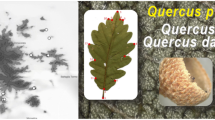Abstract
Relationships between floral elements of disjunct segments of the mixed mesophytic forest formation in eastern North America were investigated by comparison of populations ofPtelea trifoliata ssp.trijoliata in nine deciduous forest regions, using thin-layer chromatography as a supplement to morphological data. Details of leaf morphology and the presence of certain key spots in Chromatographic patterns visible under ultraviolet light were tabulated for comparison of populations. Similarities were noted between populations of the Appalachian highlands and the mountains of southern Mexico, and between the southeastern United States and the interior. Characteristics ofPtelea populations of glaciated regions indicated floral relationships with vegetation areas on both sides of the Mississippi Valley.
Similar content being viewed by others
Literature Cited
Adams, C. C. 1902. Southeastern United States as a center of geographical distribution of flora and fauna. Biol. Bull. Marine Biol. Lab. Woods Hole3: 115–131.
Bailey, H. E. &Virginia L. Bailey 1965. Phylogenetic studies on the genusPtelea (Rutaceae). Chromatography as an aid to clarification of taxonomic relationships between varieties ofPtelea trifoliata subsp.angustifolia and subsp.pallida. Lloydia28: 27–43.
Bailey, Virginia L. 1962. Revision of the genusPtelea (Rutaceae). Brittonia14: 1–45.Berry, E. W. 1930. Revision of the Lower Eocene Wilcox flora of the southeastern states with descriptions of new species chiefly from Tennessee and Kentucky. U. S. Geol. Survey Prof. Paper156: 1–196.illus.
Braun, E. Lucy 1950. Deciduous Forests of Eastern North America. Philadelphia, Pennsylvania: Blakiston Co. xiv + 569 pp.maps.
— 1955. The phytogeography of unglaciated eastern United States and its interpretation. Bot. Rev.21: 297–375.
Cain, S. A. 1930. Certain floristic affinities of the trees and shrubs of the Great Smoky Mountains and vicinity. Butler Univ. Bot. Studies1: 129–150.
Dreyer, D. L. 1969. Coumarins and alkaloids of the genusPtelea. [Part V in the series “Chemotaxonomy of the Rutaceae.”] Phytochemistry8: 1013–1020.
Fernald, M. L. 1931. Specific segregations and identities in some floras of eastern North America and the Old World. Rhodora33: 25–63. (Contr. Gray Herb., Harvard Univ. 93.)
Harshberger, J. W. 1911. Phytogeographic Survey of North America. A Consideration of the Phytogeography of the North American Continent, including Mexico, Central America and the West Indies, together with the Evolution of North American Plant Distribution. New York: G. E. Stechert & Co. lxiii + 790 pp.
Kearney, T. H. Jr. 1900. Plant geography of North America. III. The lower austral element in the flora of the southern Appalachian region. A preliminary note. Science n.s.12(309): 830–842.
Leopold, A. S. 1950. Vegetation zones of Mexico. Ecology31: 507–518.
McDougall, W. B. 1928. Mycorrhizas from North Carolina and eastern Tennessee. Amer. Jour. Bot.15: 141–148.
McVaugh, R. 1943. The vegetation of the granitic flat-rocks of the southeastern United States. Ecol. Monogr.13: 119–166.
— 1952. Suggested phylogeny ofPrunus serotina and other wide-ranging phylads in North America. Brittonia7: 317–346.
Miranda, F. &A. J. Sharp 1950. Characteristics of the vegetation in certain temperate regions of eastern Mexico. Ecology31: 313–333.
Mitchell, R. S. 1963. Phytogeography and floristic survey of a relic area in the Mariana Lowlands, Florida. Amer. Midl. Nat.69: 328–366.
Mooken, J. D., Virginia L. Bailey, &H. E. Bailey 1969. Occurrence of furoquinoline alkaloids inPtelea trifoliata. Lloydia32: 526, 527.
Mulvey, R. K. &C. J. Zalewski 1969. Kokusaginine: plant sources and its isolation fromPtelea trifoliata root bark. Econ. Bot.23: 75–81.
Sharp, A. J. 1939. Taxonomic and ecological studies of eastern Tennessee Bryophytes. Amer. Midi. Nat.21: 267–354.
— 1948. Some fungi common to the highlands of Mexico and Guatemala and eastern United States. Mycologia40: 499–502.
— 1954. Some Pteridophytes from Tamaulipas. Amer. Fern Jour.44: 72–76.
Author information
Authors and Affiliations
Additional information
Based on a thesis submitted by Shirley B. Herlin in partial fulfillment of the requirements for the degree of Master of Science in Pharmacy at Wayne State University, Detroit, Michigan, 1966.
Rights and permissions
About this article
Cite this article
Bailey, V.L., Herlin, S.B. & Bailey, H.E. Ptelea trifoliata ssp. trifoliata (Rutaceae) in deciduous forest regions of Eastern North America. Brittonia 22, 346–358 (1970). https://doi.org/10.2307/2805681
Published:
Issue Date:
DOI: https://doi.org/10.2307/2805681




